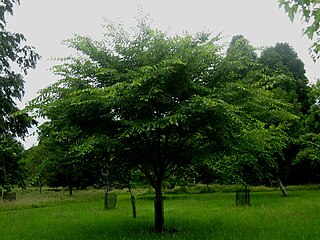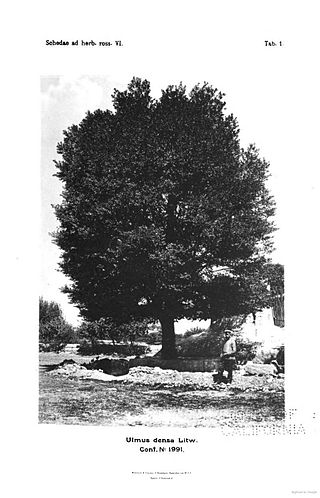
Ulmus crassifoliaNutt., the Texas cedar elm or simply cedar elm, is a deciduous tree native to south-central North America, mainly in southern and eastern Texas, southern Oklahoma, Arkansas, and Louisiana, with small populations in western Mississippi, southwest Tennessee, and north-central Florida; it also occurs in northeastern Mexico. It is the most common elm tree in Texas. The tree typically grows well in flat valley bottom areas referred to as cedar elm flats. The common name cedar elm is derived from the trees' association with juniper trees, locally known as cedars.

Ulmus pumila, the Siberian elm, is a tree native to Asia. It is also known as the Asiatic elm and dwarf elm, but sometimes miscalled the 'Chinese elm'. U. pumila has been widely cultivated throughout Asia, North America, Argentina, and southern Europe, becoming naturalized in many places, notably across much of the United States.

Ulmus davidiana var. japonica, the Japanese elm, is one of the larger and more graceful Asiatic elms, endemic to much of continental northeast Asia and Japan, where it grows in swamp forest on young alluvial soils, although much of this habitat has now been lost to intensive rice cultivation.

Ulmus bergmannianaC.K.Schneid., commonly known as Bergmann's elm, is a deciduous tree found across much of China in forests at elevations of 1500–3000 m.

Ulmus laciniata(Trautv.) Mayr, known variously as the Manchurian, cut-leaf, or lobed elm, is a deciduous tree native to the humid ravine forests of Japan, Korea, northern China, eastern Siberia and Sakhalin, growing alongside Cercidiphyllum japonicum, Aesculus turbinata, and Pterocarya rhoifolia, at elevations of 700–2200 m, though sometimes lower in more northern latitudes, notably in Hokkaido.

Ulmus macrocarpaHance, the large-fruited elm, is a deciduous tree or large shrub endemic to the Far East excluding Japan. It is notable for its tolerance of drought and extreme cold and is the predominant vegetation on the dunes of the Khorchin sandy lands in the Jilin province of north-eastern China, making a small tree at the base of the dunes, and a shrub at the top.

Ulmus changii, occasionally known as the Hangzhou elm, is a small deciduous tree found across much of China in forests at elevations of up to 1800 m. Owing to its increasing scarcity, U. changii was added to the Hainan Province Protected Plants List in 2006.

Ulmus elongata, also known as the long raceme elm in the US, is a deciduous tree endemic to broadleaf forests in the eastern provinces of China.

Ulmus microcarpa was named and first described by the Chinese botanist L. K. Fu, who discovered the tree in the Chayu broad-leaved forests of south-eastern Xizang at altitudes of around 2800 m during the 1973 Qinghai - Tibet Expedition. Unlike the majority of Tibet, the Chayu region has a subtropical highland climate featuring warm, wet, summers and mild, dry, winters. Commonly known as the Tibetan Elm, the tree was introduced to the United States in 2006, and the UK in 2013; it remains one of the rarest species of elm in cultivation.
Ulmus chumlia is a small deciduous tree endemic to the Himalaya from the Kashmir to central Nepal, and the provinces of Yunnan, Sichuan and Xizang (Tibet) in China. It is found in broadleaf forest on mountain slopes at elevations of 1000–3000 m. Richens noted that the species appeared to be the same as that named by Grudzinskaya as Ulmus androssowii var. virgata, which she considered an intermediate between U. minor and U. pumila.

Ulmus davidiana, also known as the David elm, or Father David elm, is a small deciduous tree widely distributed across China, Mongolia, Korea, Siberia, and Japan, where it is found in wetlands along streams at elevations of 2000–2300 m (6,500–7,500 ft). The tree was first described in 1873 from the hills north of Beijing, China.

Ulmus lanceifoliaRoxburgh, ex Wall., occasionally known as the Vietnam elm, is a very large tree endemic to a wide area of southern Asia. Its range extends southeast and eastwards from Darjeeling in the Himalaya, through Bangladesh, southern China, Myanmar, Thailand, Laos, Vietnam and on discontinuously into Indonesia, straddling the Equator in Sumatra and Celebes.
Ulmus pseudopropinquaWang & Li, occasionally known in the United States as the Harbin spring elm, is a small deciduous tree found only in Heilongjiang, the northeasternmost province in China. The tree has not been studied comprehensively, and it has been speculated it may be a natural hybrid of Ulmus davidiana var. japonica and Ulmus macrocarpa.

Ulmus 'Morton' is an elm cultivar cloned from a putative intraspecific hybrid planted at the Morton Arboretum in 1924, which itself originated as seed collected from a tree at the Arnold Arboretum in Massachusetts. Although this tree was originally identified as Ulmus crassifolia, it is now believed to have been a hybrid of the Japanese elm and Wilson's elm. Accolade has proven to be the most successful cultivar tested in the US National Elm Trial, averaging a survival rate of 92.5% overall.

The Japanese elm cultivar Ulmus davidianavar.japonica 'Prospector' was originally treated as a cultivar of Wilson's elm U. wilsonianaSchneid., a species sunk as Ulmus davidiana var. japonica by Fu. A U.S. National Arboretum introduction, it was selected in 1975 from a batch of 1965 seedlings in Delaware, Ohio, and released without patent restrictions in 1990. 'Prospector' proved moderately successful in the US National Elm Trial, averaging a survival rate of 76% overall.
Ulmus glaucescens var. lasiocarpaRehder, named the hairy-fruited glaucescent elm in the United States, is a Chinese tree found along rivers and mountain slopes at elevations of 2500–2600 m in the provinces of Hebei, Henan, Liaoning, Nei Mongol, Ningxia, eastern Qinghai, and Shanxi.
Ulmus macrocarpa var. macrocarpaL. K. Fu is found on hillslopes and in valleys at elevations of 700–800 m in the Chinese provinces of Anhui, Gansu, Hebei, Heilongjang, Henan, Hubei, Jiangsu, Jilin, Liaoning, Nei Mongol, eastern Qinghai, Shaanxi, Shanxi, Shandong. Beyond China it is also found in Korea, Mongolia, and Russia (Siberia).

The elm cultivar UlmusDensa was described from specimens growing near Ashkabad as U. densaLitv. in Schedae ad Herbarium Florae Rossicae (1908). Litvinov, reporting it growing wild in the mountains of Turkestan, Ferghana, and Aksu, as well as in cultivation, considered it a species, a view upheld by the Soviet publications Trees and Shrubs in the USSR (1951) and Flora of Armenia (1962), and by some current plant lists. Other authorities take it to be a form of U minor, distinctive only in its dense crown and upright branching. The Moscow State University herbarium gives (2020) Ulmus minor as the "accepted name" of U. densaLitv..













